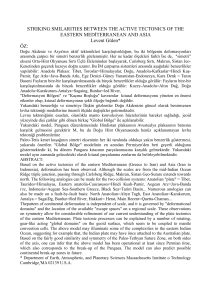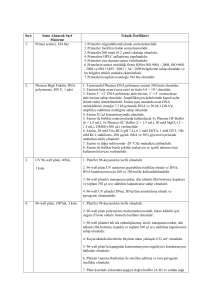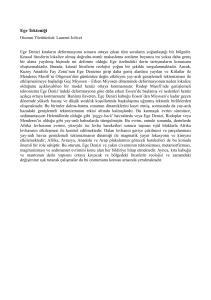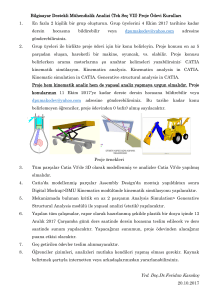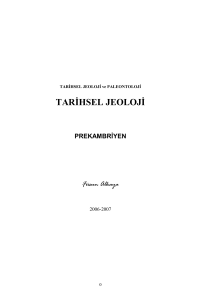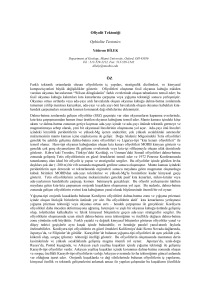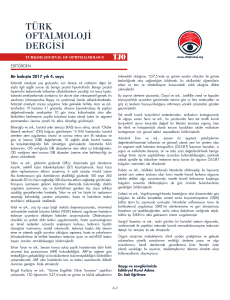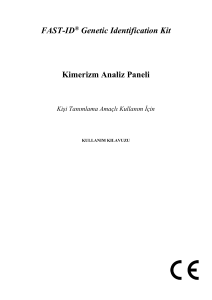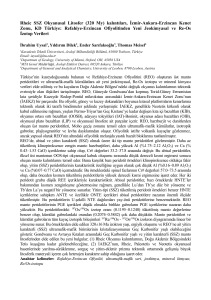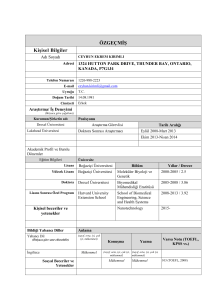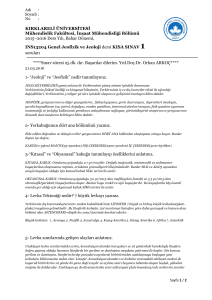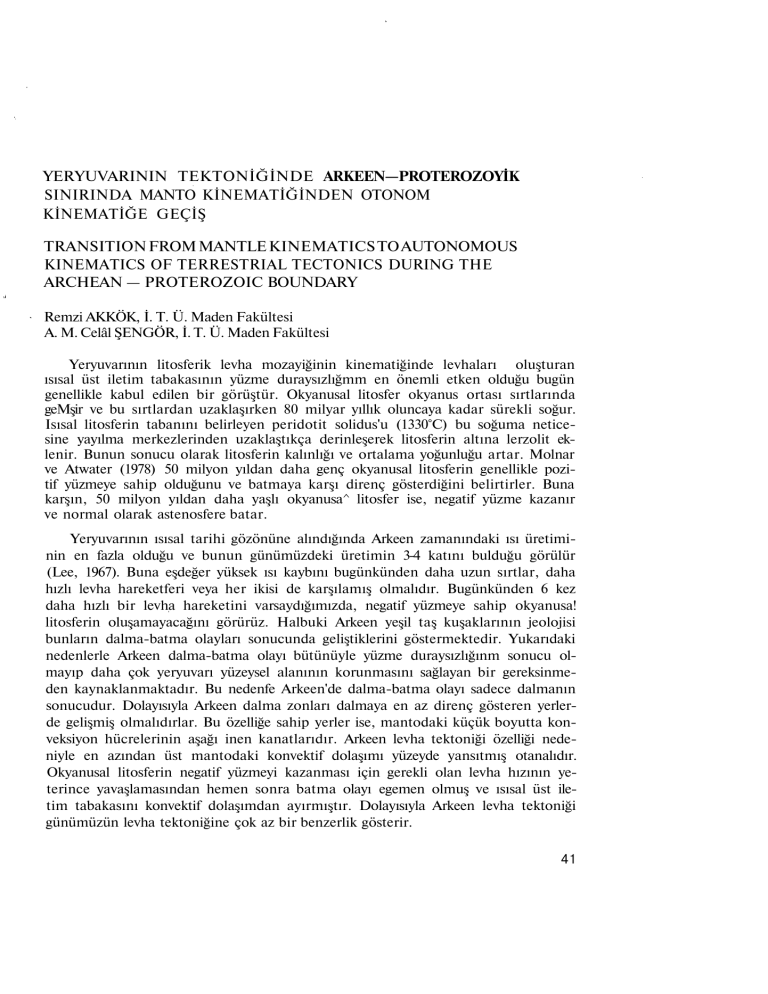
YERYUVARININ TEKTONİĞİNDE ARKEEN—PROTEROZOYİK
SINIRINDA MANTO KİNEMATİĞİNDEN OTONOM
KİNEMATİĞE GEÇİŞ
TRANSITION FROM MANTLE KINEMATICS TO AUTONOMOUS
KINEMATICS OF TERRESTRIAL TECTONICS DURING THE
ARCHEAN — PROTEROZOIC BOUNDARY
Remzi AKKÖK, İ. T. Ü. Maden Fakültesi
A. M. Celâl ŞENGÖR, İ. T. Ü. Maden Fakültesi
Yeryuvarının litosferik levha mozayiğinin kinematiğinde levhaları oluşturan
ısısal üst iletim tabakasının yüzme duraysızlığmm en önemli etken olduğu bugün
genellikle kabul edilen bir görüştür. Okyanusal litosfer okyanus ortası sırtlarında
geMşir ve bu sırtlardan uzaklaşırken 80 milyar yıllık oluncaya kadar sürekli soğur.
Isısal litosferin tabanını belirleyen peridotit solidus'u (1330°C) bu soğuma neticesine yayılma merkezlerinden uzaklaştıkça derinleşerek litosferin altına lerzolit eklenir. Bunun sonucu olarak litosferin kalınlığı ve ortalama yoğunluğu artar. Molnar
ve Atwater (1978) 50 milyon yıldan daha genç okyanusal litosferin genellikle pozitif yüzmeye sahip olduğunu ve batmaya karşı direnç gösterdiğini belirtirler. Buna
karşın, 50 milyon yıldan daha yaşlı okyanusa^ litosfer ise, negatif yüzme kazanır
ve normal olarak astenosfere batar.
Yeryuvarının ısısal tarihi gözönüne alındığında Arkeen zamanındaki ısı üretiminin en fazla olduğu ve bunun günümüzdeki üretimin 3-4 katını bulduğu görülür
(Lee, 1967). Buna eşdeğer yüksek ısı kaybını bugünkünden daha uzun sırtlar, daha
hızlı levha hareketferi veya her ikisi de karşılamış olmalıdır. Bugünkünden 6 kez
daha hızlı bir levha hareketini varsaydığımızda, negatif yüzmeye sahip okyanusa!
litosferin oluşamayacağını görürüz. Halbuki Arkeen yeşil taş kuşaklarının jeolojisi
bunların dalma-batma olayları sonucunda geliştiklerini göstermektedir. Yukarıdaki
nedenlerle Arkeen dalma-batma olayı bütünüyle yüzme duraysızlığınm sonucu olmayıp daha çok yeryuvarı yüzeysel alanının korunmasını sağlayan bir gereksinmeden kaynaklanmaktadır. Bu nedenfe Arkeen'de dalma-batma olayı sadece dalmanın
sonucudur. Dolayısıyla Arkeen dalma zonları dalmaya en az direnç gösteren yerlerde gelişmiş olmalıdırlar. Bu özelliğe sahip yerler ise, mantodaki küçük boyutta konveksiyon hücrelerinin aşağı inen kanatlarıdır. Arkeen levha tektoniği özelliği nedeniyle en azından üst mantodaki konvektif dolaşımı yüzeyde yansıtmış otanalıdır.
Okyanusal litosferin negatif yüzmeyi kazanması için gerekli olan levha hızının yeterince yavaşlamasından hemen sonra batma olayı egemen olmuş ve ısısal üst iletim tabakasını konvektif dolaşımdan ayırmıştır. Dolayısıyla Arkeen levha tektoniği
günümüzün levha tektoniğine çok az bir benzerlik gösterir.
41
Manto kinematiğinden levha kinematiğinin ayrılması yeryuvarının termal ve
tektonik tarihinde Arkeen-Proterozoyik sınırında bir yerde önemli bir geçişin bulunduğunu gösterir. Bu geçişin varlığının saptanması tektonikte bazı sorunlara
önemli ölçüde ışık tutmaktadır. Ne yazık ki jeolojik kayıtta sadece dalma-batma
zonlarımn izlerinin kalması da bu geçişi direkt olarak belgelemeyi güçleştirmektedir.
it is today generally accepted that the kinematics of the terrestrial lithospheric
plate mosaic is largely dictated b'y the buoyant instability of the boundary conducti'on layer forming the plates. Oceariic lithosphere is created at the mi'd-ocean ridges and it cools continuously as it moves away from them until it is about 80 m.
y.-old. The cooling of the oceanic lithosphere results in its thickening because the
peridotite solidus •(13'30°C) defining the base of the thermal lithosphere subsides
away from the spreading centres thereby adding lherzolite to its base and aügmenting its density. As Mobıar and Atwater (1978) showed oceanic lithosphere younger
than 50 m. y. generally has a positive buoyancy and therefore resists subduction.
Oceanic lithosphere older than 50 m. y. acquires a negative buoyancy andnormally
sinks in to the asthenosphere by subduction.
Consideratio'ns on the thermal history of the Earth show that during the
Archean the heat production of the earth was 3 to 4 times more than that of the
present (Lee 1967). This must have been compenşated by an equi'valent high heat
loss which ,must have been accomplished either by a longer ridge length or faster
plate motion than those of today, or both. We here make the simple observation
that under the assumption of a plate motion rate SIK times faster tha'n that of
today, would be impossible to create negatively buoyant oceanic lithosphere. Yet
the geology of the Archean greenstone belts indicate that they were genarated by
subduction. Therefore the Archean subduction was not a result of buoyant instability,
but rather a kinematic 'necessity to conserve the surface area of the planet. Hence,
Archean subduction zones would have followed where there was leastdynamic
resistance to downgoing movement, such zones were zones were most likely the
!
downgoin g limbs of the small-scale convection cells in the mantle. This indicates
that the Archean plate tectonics portrayed a faithful image of the convective circulation of at least the upper mantle. As soon as the plate motion slowed down
sufficiently to allow the oceanic lithosphere to acquire negative buoyancy, the
slab-pull effect became dominant and esse'ntially detached the thermal boundary
conduction layer from the mantle circulation. The present plate kinematics bears
little resemblance to mantle kinematics.
The seraration of mantle kinematics and plate kinematics represents a significa'nt transition in the thermal and tectonic history of our planet, somewhere at
the Archean-Proterozoic boundary. This has a number of significant implications
for tectonics. Yet it would be impossible to detect it directly by field geological
methods, because only the record of subduction zones have been preserved in any
detail.
42

